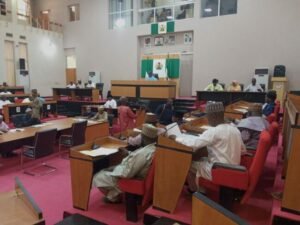
Yobe Govt rolls out 2025 flood disaster response, preparedness plan
By Baba Dan’iya
Dr Goje Mohammed, Executive Secretary, Yobe State Emergency Management Agency (SEMA), says the government has strengthened emergency response and preparedness to mitigate the impact of floods in the state.
Mohammed stated this on Monday in Damaturu while presenting the 2025 Flood Disaster Response and Preparedness Plan at a press conference with the theme “Strengthening Emergency Response and Building Community Resilience.”
He said under the leadership of Gov. Mai Mala Buni, the government had placed emergency response and community resilience at the centre of its development priorities.
According to him, the governor has consistently mobilised resources for timely interventions, ensuring that displaced families receive relief and medical support without delay.
Mohammed recalled that on Aug. 15, a flash flood in Potiskum LGA displaced 2,557 households across 21 settlements, and the state immediately provided shelters, food, and medical assistance.
Similarly, on Aug. 17, SEMA responded to distress calls in Garin Kolo and Ajim communities in Nangere LGA, where 550 households were affected.
“Emergency measures included sandbagging, food distribution, safe water provision, and sanitation kits to prevent disease outbreaks,” he said.
The executive secretary commended the contributions of ministries, agencies, volunteers and humanitarian partners such as NEMA, NEDC, IOM, UNICEF, FAO, Red Cross, and Save the Children International.
He added that traditional leaders, local authorities and faith-based groups had also played vital roles in ensuring inclusive, community-owned interventions.
Unveiling the 2025 Flood Preparedness Plan, Mohammed said it targeted 126,000 households in high-risk LGAs, with contingency arrangements for 15,967 potentially displaced persons.
The plan, he explained, was informed by forecasts from the Nigerian Meteorological Agency (NiMet) and the Nigeria Hydrological Services Agency (NIHSA) as well as lessons from previous floods.
Key features include real-time river monitoring, digital reporting systems, activation of Local Emergency Management Committees, mobilisation of 178 community volunteers and prepositioning of contingency stocks.
Others are capacity building for response teams, training in search-and-rescue operations, stockpiling of food for 20,000 households, and distribution of shelter materials and non-food items.
The state also mapped flood-prone areas, reinforced embankments, and launched a sensitisation campaign, including a “Kick Flood” soccer event to raise awareness among youths.
Mohammed said contingency plans were developed for 10 LGAs, while community-based early warning and anticipatory action structures were established in flood-prone communities.
He urged partners, federal agencies, civil society, the private sector and communities to redouble efforts and align interventions with the state plan to avoid duplication.
“The journey of building resilience against floods in Yobe is ongoing. We must act decisively, prepare comprehensively and strengthen partnerships that save lives and protect livelihoods,” Mohammed said.
He reaffirmed the state government’s commitment to ensuring that no community is left behind in flood preparedness and response.


